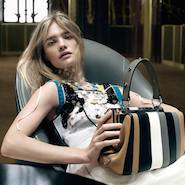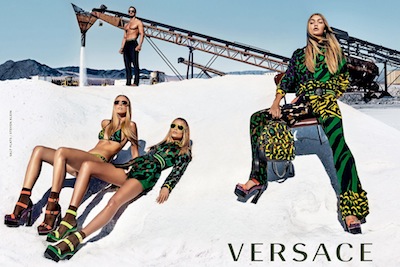 Prada spring/summer 2016 campaign
Prada spring/summer 2016 campaign
Marketers’ expenditure on luxury advertising is forecasted to increase by 3 percent in 2016, according to a new report by Zenith.
The rise in ad spend, up 1.9 percent from the year-ago, is being driven by recovery in the Asian and Eastern European markets after a challenging 2015. Zenith’s “Luxury Advertising Expenditure Forecasts 2016” predicts that advertisers will spend $10.9 billion across the top 18 markets compared to the $10.6 billion spent in 2015.
"The report shows that luxury advertising can grow at quite different rates in different years, in different countries and for different reasons,"said Jonathan Barnard, head of forecasting, communications director at Zenith, part of Publicis Groupe. "Brands need to monitor their competitors’ activity carefully to avoid losing share of voice.
"But it is more important for brands to make sure they spend their budgets in the media that allow them to communicate with their potential customers in the most effective ways, to take advantage of any opportunities afforded by economic growth and market innovation," he said.
"I was quite surprised to see that the UK is forecast to overtake France, such an iconic luxury market, in luxury ad spend this year."
The Luxury Advertising Expenditure Forecasts is Zenith’s second annual addition. Zenith has been publishing a broad Advertising Expenditure Forecasts report for almost 30 years, making its findings an industry standard source for analysis of advertising trends.
Market check
For the forecast, Zenith surveyed 18 markets: China, Colombia, France, Germany, Hong Kong, Italy, Malaysia, Mexico, the Netherlands, Peru, Russia, Singapore, South Africa, South Korea, Spain, Taiwan, the United Kingdom and the United States.
To gain insights into luxury advertising trends, Zenith focused specifically on subcategories such as automotive, fragrance and beauty, apparel and accessories and watches and jewelry.
Over the last few years, the luxury market has been affected by slowing BRIC markets in addition to local conflicts and acts of terrorism. These events have resulted in the luxury advertising market slowing from 2.9 percent growth in 2014 to only 1.9 percent in 2015.
 Versace spring/summer 2016
For example, the Asian region’s ad spend declined by 1.4 percent while Eastern Europe saw a steep decline of 20.3 percent. Eastern Europe’s ad spend decline was a result of the oil crisis and Russia’s currency devaluation.
Comparably, North America and Western Europe saw signs of growth, with an increase of 3.6 percent and 4.7 percent, respectively.
Despite Asia’s slowdown in 2015, Zenith predicts in its forecast the market will return to a pattern of growth with a 2.9 percent increase for 2016. But, the decline in Eastern Europe continues although at a smaller rate of 2.8 percent.
Likewise, North America continues at 3.9 percent growth whereas Western Europe, due to recent events linked to terrorism, will decline by 1.7 percent.
While luxury advertising in some markets is faring well, the category is growing slower than advertising as a whole. Zenith found that luxury advertising grew by 2.9 percent, but the industry grew 5.6 percent as a whole.
Versace spring/summer 2016
For example, the Asian region’s ad spend declined by 1.4 percent while Eastern Europe saw a steep decline of 20.3 percent. Eastern Europe’s ad spend decline was a result of the oil crisis and Russia’s currency devaluation.
Comparably, North America and Western Europe saw signs of growth, with an increase of 3.6 percent and 4.7 percent, respectively.
Despite Asia’s slowdown in 2015, Zenith predicts in its forecast the market will return to a pattern of growth with a 2.9 percent increase for 2016. But, the decline in Eastern Europe continues although at a smaller rate of 2.8 percent.
Likewise, North America continues at 3.9 percent growth whereas Western Europe, due to recent events linked to terrorism, will decline by 1.7 percent.
While luxury advertising in some markets is faring well, the category is growing slower than advertising as a whole. Zenith found that luxury advertising grew by 2.9 percent, but the industry grew 5.6 percent as a whole.
 Mulberry's Bayswater handbag effort
While this “underperformance” is expected to continue, the U.S. and China are driving luxury advertising’s growth.
By 2017, Zenith predicts that luxury advertising will grow by $705 million, with 82 percent of that growth stemming from the U.S. and China, broken down to $347 million and $228 million, respectively.
As the largest and second largest luxury ad markets, the U.S. accounted for 45 percent of the luxury ad spend in 2015 whereas China represented 21 percent of luxury ad spend. Germany, France and the UK round out the top five luxury markets for ad spend.
Going forward, France is unlikely to see much growth due to unemployment, low consumer confidence and limited economic growth. Zenith feels that the UK will replace France as the fourth-largest luxury ad market within 2016.
“The growth of the UK luxury ad market has chiefly been driven by increasing employment and lower savings among UK consumers, and rising numbers of tourists entering the country,” Mr. Barnard said.
“All of these factors are increasing the amount of money available for spending on luxury items, giving UK brands the opportunity to expand the luxury market as a whole, as well as fight for market share,” he said.
Mediums
It goes without saying that digital advertising will continue to contribute to luxury advertising’s growth. To that point, Zenith expects digital media ad spend to increase by $837 million between the year-ago and 2017.
During this two-year time frame, television, radio and cinema will increase by $26 million, while outdoor marketing will decline by $10 million and print by a staggering $150 million.
Television has been on the decline for a number of years, with a market-share decline from 32.7 percent in 2015 to 30.7 percent in 2017. Print will fare similarly, with an ad spend total of 28.6 percent by 2017, a decrease from 2015’s 31.9 percent.
These mediums will be replaced by digital as the single largest platform for luxury advertising. Digital will see a 32.1 percent increase in ad spend by 2017, compared to 26.3 percent in 2015.
Even though print is on the decline, the medium is the most impactful when marketing to affluent consumers, especially for advertisers dealing in apparel and accessories and watches and jewelry.
Zenith found that in 2015, apparel and accessories advertisers spent 83 percent of their ad budgets in print and 60 percent of watch and jewelry advertisers did the same.
Although digital is quickly becoming the preferred marketing medium, print media still holds a place in the luxury advertising mix. This is especially true for glossy magazines where brand ideals are showcased in a high-quality and relaxed reading experience.
Print’s role is evolving as content marketing extends across more platforms, according to panelists at a Fordham Graduate Business School event.
Rather than being the primary place for brands to tell their stories, print serves as a special occasion, while digital content serves the purpose of engaging on a more consistent basis. Brands therefore need to find ways to reach consumers in both short-form and long-form content, making a three-second impression on a phone or telling a more extensive story in editorial (see story).
“Print is not the best medium for all luxury brands, but for many watches, jewelry, fashion and accessory brands, magazines in particular provide an ideal complement to their brand values,” Mr. Barnard said.
“Magazine readers are normally relaxed and at leisure, and will normally devote their undivided attention to what they’re reading,” he said. “The print quality is high, and the content is often glamorous and aspirational.
“Magazines provide an ideal environment for brands to strengthen their association with these values.”
Mulberry's Bayswater handbag effort
While this “underperformance” is expected to continue, the U.S. and China are driving luxury advertising’s growth.
By 2017, Zenith predicts that luxury advertising will grow by $705 million, with 82 percent of that growth stemming from the U.S. and China, broken down to $347 million and $228 million, respectively.
As the largest and second largest luxury ad markets, the U.S. accounted for 45 percent of the luxury ad spend in 2015 whereas China represented 21 percent of luxury ad spend. Germany, France and the UK round out the top five luxury markets for ad spend.
Going forward, France is unlikely to see much growth due to unemployment, low consumer confidence and limited economic growth. Zenith feels that the UK will replace France as the fourth-largest luxury ad market within 2016.
“The growth of the UK luxury ad market has chiefly been driven by increasing employment and lower savings among UK consumers, and rising numbers of tourists entering the country,” Mr. Barnard said.
“All of these factors are increasing the amount of money available for spending on luxury items, giving UK brands the opportunity to expand the luxury market as a whole, as well as fight for market share,” he said.
Mediums
It goes without saying that digital advertising will continue to contribute to luxury advertising’s growth. To that point, Zenith expects digital media ad spend to increase by $837 million between the year-ago and 2017.
During this two-year time frame, television, radio and cinema will increase by $26 million, while outdoor marketing will decline by $10 million and print by a staggering $150 million.
Television has been on the decline for a number of years, with a market-share decline from 32.7 percent in 2015 to 30.7 percent in 2017. Print will fare similarly, with an ad spend total of 28.6 percent by 2017, a decrease from 2015’s 31.9 percent.
These mediums will be replaced by digital as the single largest platform for luxury advertising. Digital will see a 32.1 percent increase in ad spend by 2017, compared to 26.3 percent in 2015.
Even though print is on the decline, the medium is the most impactful when marketing to affluent consumers, especially for advertisers dealing in apparel and accessories and watches and jewelry.
Zenith found that in 2015, apparel and accessories advertisers spent 83 percent of their ad budgets in print and 60 percent of watch and jewelry advertisers did the same.
Although digital is quickly becoming the preferred marketing medium, print media still holds a place in the luxury advertising mix. This is especially true for glossy magazines where brand ideals are showcased in a high-quality and relaxed reading experience.
Print’s role is evolving as content marketing extends across more platforms, according to panelists at a Fordham Graduate Business School event.
Rather than being the primary place for brands to tell their stories, print serves as a special occasion, while digital content serves the purpose of engaging on a more consistent basis. Brands therefore need to find ways to reach consumers in both short-form and long-form content, making a three-second impression on a phone or telling a more extensive story in editorial (see story).
“Print is not the best medium for all luxury brands, but for many watches, jewelry, fashion and accessory brands, magazines in particular provide an ideal complement to their brand values,” Mr. Barnard said.
“Magazine readers are normally relaxed and at leisure, and will normally devote their undivided attention to what they’re reading,” he said. “The print quality is high, and the content is often glamorous and aspirational.
“Magazines provide an ideal environment for brands to strengthen their association with these values.”
